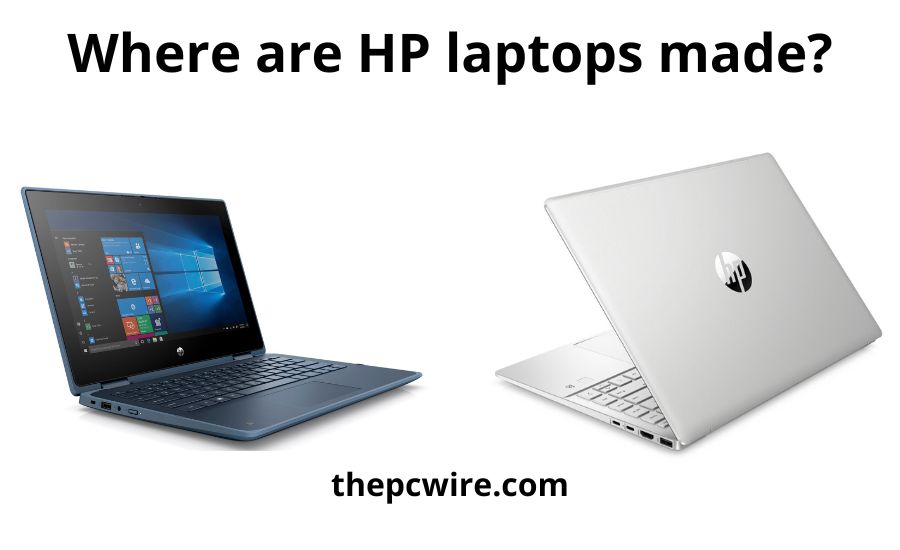Where are HP laptops made? HP, a prominent manufacturer among laptop brands founded by Dave Packard and Bill Hewlett and initially named Hewlett Packard, operates different locations for manufacturing crucial to understanding the production of their devices.

Where are HP laptops made: global manufacturing presence
HP company, founded by Dave Packard in 1939 (initially named Hewlett Packard and throughout its history received an order from Walt Disney and produced military equipment like counter radar technology), boasts a robust global presence in the laptops’ manufacturing sector, strategically establishing manufacturing plants across different markets and different locations.
With an extensive network of manufacturing sites, the company ensures a widespread reach to efficiently cater to the demands of the global market for its laptops and desktop computers.
These facilities, located in key various locations worldwide, form the backbone of HP’s production capabilities, enabling the company to maintain a competitive edge and consistently deliver high-quality laptops to consumers across the globe.

Where are HP laptops made: various locations
So, where are HP laptops made? In certain locations, HP strategically positions facilities for producing laptops without any disruptions and ensures quality standards.
China
China serves as a cornerstone in the manufacturing network, housing a crucial manufacturing facility chain that makes HP desktop computers, laptops, and PC accessories.
Key facilities: the company operates multiple major manufacturing plants in China, strategically positioned across regions renowned for technological infrastructure and industrial development.
Role in production: it’s worth noting that these facilities are equipped with cutting-edge technology and specialized production lines dedicated to various stages of producing laptops, encompassing component assembly, rigorous testing, quality assurance measures, and packaging processes.
Integration and collaboration: collaborative efforts with an extensive network of suppliers and partners enable the company to streamline the HP laptop and laptop components’ supply chain.
This collaboration ensures a steady flow of components and materials necessary for producing laptops, enhancing efficiency and responsiveness to market demands.
Quality standards: the company maintains stringent quality standards across its Chinese manufacturing and assembly plants, ensuring that the laptops and computers produced meet the company’s high-quality benchmarks before reaching consumers worldwide.
Taiwan
Taiwan hosts specialized HP facilities, key to leveraging the region’s technological expertise in producing laptops.
Specialized production: these manufacturing and assembly plants focus on specialized aspects of producing laptops, often involving the assembly of specific components from raw materials or the integration of cutting-edge technologies into HP devices.
Collaborative partnerships: the presence of HP in Taiwan involves collaborative partnerships with local tech firms and suppliers, enabling access to specialized components and fostering innovation within the manufacturing processes.
Strategic positioning: the strategic placement of these facilities within Taiwan’s technology-rich landscape allows the company to tap into the region’s skilled workforce and advanced infrastructure.

Mexico
Mexico serves as a pivotal manufacturing hub for the company, offering strategic advantages in producing laptops and personal computers for both local and global markets.
Manufacturing hub: Mexico serves as a significant manufacturing hub for the company, hosting key facilities responsible for various stages of producing HP laptops, from assembly plants to distribution chains.
Proximity to markets: the strategic location of these manufacturing plant facilities in Mexico allows HP to efficiently cater to the North American market while also enabling easier access to other global regions.
Trade agreements: leveraging trade agreements like the United States-Mexico-Canada Agreement (USMCA), the company can navigate international trade barriers more effectively, facilitating smoother import/export processes for components and finished products.
United States
The United States houses key HP manufacturing and assembly plants pivotal to the company’s innovation and contribution to the global production of HP laptops and personal computers.
Strategic facilities: the HP company maintains facilities in the United States, strategically positioned to contribute significantly to the company’s overall laptop production.
Focus on innovation: these manufacturing facilities often emphasize research, development, and innovation, contributing to the creation of cutting-edge technologies and designs incorporated into HP laptop models.
Market responsiveness: having manufacturing plant facilities within the U.S. enables HP to respond swiftly to market demands in the region, reducing shipping times and facilitating quicker product launches.

HP’s manufacturing processes
HP laptop manufacturing involves intricate processes, stringent quality control, and innovative technologies to deliver high-performance devices.
Overview of manufacturing processes
Assembly line operations: HP uses streamlined assembly line processes for producing HP laptops, encompassing stages from component assembly to final product completion.
Component integration: this involves integrating various components, including processors, memory modules, displays, and keyboards, into the laptop chassis through automated and precise procedures.
Testing and quality assurance: rigorous testing protocols ensure the functionality, performance, and durability of each laptop before packaging and distribution.

Quality control measures and sustainability efforts
Quality assurance protocols: HP implements stringent quality control measures at every stage of manufacturing to meet and surpass industry standards, ensuring reliable and durable HP laptops and desktop computers.
Technological advancements in production
Automation and robotics: HP incorporates advanced automation and robotics in manufacturing processes to enhance precision, speed, and efficiency while reducing errors.
3D printing and customization: using 3D printing technologies, HP explores customization options and rapid prototyping for specific components, enhancing flexibility in production.

Factors influencing manufacturing locations
The location system that makes HP desktop computers and HP laptops is shaped by various critical factors, encompassing cost-effectiveness, supply chain dynamics, and geopolitical considerations.
Cost-effectiveness
Labor costs: HP carefully assesses labor expenses in potential locations for manufacturing and testing equipment.
The company seeks regions with competitive wages in the labor market while ensuring skilled workforces that align with HP quality and productivity standards to produce laptops.
Operational expenses: analysis of operational costs aids in selecting locations that offer favorable operational expenses without compromising production quality.
Supply chain considerations
Proximity to suppliers: strategic placement of manufacturing sites near component suppliers reduces transportation costs and lead times.
This proximity streamlines the supply chain, ensuring timely access to essential raw materials required for producing HP laptops.
Distribution logistics: HP considers the efficiency of distribution networks in potential locations, aiming to establish facilities near key markets to minimize logistical complexities and shorten delivery times to consumers.

Geopolitical factors impacting location choices
Trade regulations and tariffs: HP navigates through various trade regulations and tariffs, selecting manufacturing locations to produce laptops that mitigate potential trade barriers and tariffs.
This proactive approach helps in avoiding unnecessary costs and disruptions in international trade.
The HP company prioritizes locations with favorable political climates and stable economic conditions to ensure continuous and uninterrupted operations.

Conclusion
In balancing cost-effectiveness, supply chain efficiency, and geopolitical stability, HP strategically selects manufacturing locations, ensuring the production of high-quality laptops to meet diverse market demands worldwide.
FAQ
Yes, HP laptops and other products are manufactured in various countries and are particularly made in China.
HP operates manufacturing facilities where certain models and components of HP laptops are made in China.
HP also manufactures desktop computers in the United States.
The company has manufacturing facilities in the USA where some HP desktop computers, including certain models of laptops, are assembled and produced.
HP laptops are assembled in various locations worldwide.
The assembly process takes place in different countries where HP has manufacturing facilities, including China, Taiwan, Mexico, and the United States, among others.
Yes, reports suggest that HP is diversifying its laptop production beyond China. The HP company is shifting millions of HP desktop computers and laptops to certain locations like Thailand and Mexico, aiming to reduce reliance on China and diversify its supply chain.
This move aligns with similar strategies adopted by other laptop brands like Dell (with Dell laptops) and Apple during the pandemic to mitigate disruptions, marking HP’s proactive efforts in diversifying its manufacturing locations.
Yes, Quanta Computer collaborates with HP, playing a significant role in producing their devices.

Hi, this is Masab, the owner and founder of the PC Wire. I’m a PC enthusiast who loves to talk about computers. I have been testing PC hardware for several years now, and I hope my knowledge would answer your queries thoroughly.

